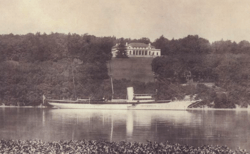Col. Oliver Hazard Payne Estate
|
Col. Oliver Hazard Payne Estate | |
 | |
|
Payne Mansion with yacht Aphrodite c.1912 | |
 | |
| Location | US 9W, Esopus, New York |
|---|---|
| Coordinates | 41°48′35″N 73°57′34″W / 41.80972°N 73.95944°WCoordinates: 41°48′35″N 73°57′34″W / 41.80972°N 73.95944°W |
| Area | 60 acres (24 ha) |
| Built | 1905 |
| Architect | Carrere and Hastings |
| Architectural style | Renaissance |
| Governing body | Private |
| NRHP Reference # | 02001324[1] |
| Added to NRHP | November 15, 2002 |
Col. Oliver Hazard Payne Estate is a historic 60-acre (24 ha) estate located on the west bank of the Hudson River at Esopus in Ulster County, New York. It has a 42,000-square-foot (3,900 m2) Beaux Arts-style Mediterranean palazzo with an open courtyard designed in 1905 by the architect Thomas Hastings of the renowned firm Carrere and Hastings, who also designed the New York Public Library and the Frick Collection. It is constructed of reinforced concrete and faced with Italian limestone topped by red tile clad hipped roofs. The eastern portico has six single-story Ionic columns set between rugged arched pavilions and is fronted by a balustraded terrace overlooking the river. At the palazzo's center is an enclosed courtyard fitted with a fountain and recessed loggias adorned with frescoes. Located nearby on the riverbank is a stone boat house that is part of the estate.[2] The boathouse, built soon after the palazzo, is a rare survivor of its type on the river, it is neither Italian Renaissance nor rustic, but somewhere between the two.[3]
Now owned by Marist College it is one of the most architecturally significant houses in the Hudson Valley.[4]
It was listed on the National Register of Historic Places in 2002.[1]
History
He served as a colonel in the American Civil War, during which time he was grievously wounded. Following this he became involved in oil refining and founded the company Clark, Payne & Co. In 1872 it was purchased by John D. Rockefeller. Payne became the treasurer of Standard Oil and one of the wealthiest men in America. He constructed the mansion in 1909-1911 on the same site as Waldorf, John Jacob Astor III’s somewhat less grand Renaissance-style residence that was razed.[3] Payne never married nor had children. Upon his death in 1917, the house passed to one of his nephews, Harry Payne Bingham. Bingham donated the 484 acre estate to the Episcopal Diocese of New York in 1933, which established the Wiltwyck School for Boys, serving troubled children from 1937-1966.[3] Its leaders included Eleanor Roosevelt, and its alumni included boxing champion Floyd Patterson.[3]
60 acres of the estate, including the mansion, was purchased by the Marist Brothers, founders of Marist College, in 1942; it was used as a retreat for several years.[3]
The estate was purchased from the Marist Brothers by Raymond A. Rich (1912–2009) in 1986. Rich was a wealthy businessman and industrialist. Following his purchase, he restored the mansion to its former glory. Rich was the CEO of U.S. Filters Corp during the 1970s. He resided in the mansion until his death in June 2009.[5]
In September 2009, it was revealed that Rich had bequeathed the estate to Marist College, located on the other side of the Hudson River.[3] The estate was conservatively estimated to be worth $65 million at the time.[6] Additionally, Rich set aside $10 million for the school to establish a leadership institute.[4] This brings the estate full circle following its ownership by the Marist Brothers. The estate has since been part of the Raymond A. Rich Leadership Institute at Marist; the mansion is used for speakers, conferences and workshops by the school.[6]
References
- ↑ 1.0 1.1 "National Register Information System". National Register of Historic Places. National Park Service. 2009-03-13.
- ↑ Bonafide, John A. (June 2002). "National Register of Historic Places Registration: Col. Oliver Hazard Payne Estate". New York State Office of Parks, Recreation and Historic Preservation. Retrieved 2010-03-20.(Java plugin required) See also: "Accompanying 17 photos".(Java plugin required)
- ↑ 3.0 3.1 3.2 3.3 3.4 3.5 "Houses and Estates in Ulster County New York: The Architectural History and Guide Book". Hudson Valley Magazine. 2012-05-21.
- ↑ 4.0 4.1 "Marist College given 75 million dollar bequest for new leadership program". Poughkeepsie Journal. 2009-09-23. Retrieved 2013-03-04.
- ↑ "Paid Notice: Deaths Rich, Raymond A.". The New York Times. 24 June 2009. Retrieved 2012-08-09.
- ↑ 6.0 6.1 "The Raymond A. Rich Institute for Leadership Development". Marist College.
| |||||||||||||||||||||||||
| ||||||||||||||||


